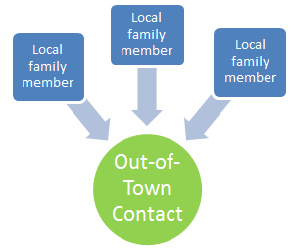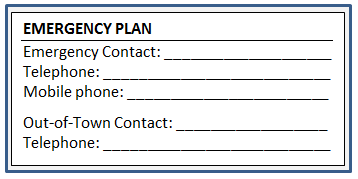Where will you be when a disaster strikes?
You can almost assume that when an emergency hits, your family will not be together. Depending on the circumstances, you may not be able to get back together for some time.
- Students and teachers may be held in school, perhaps in a locked-down situation. They will not be released until it is deemed safe by authorities. If you’re not available who will claim them?
- Employees may be needed to stand by to help protect co-workers as well as save the business itself.
- City employees and First Responders are likely to be called into action before knowing the condition of their own homes and family members. They may be away from home for hours or days at a time.
- Any family member could be away from the home on travel, shopping, or vacation.
Immediately following the disaster, your concern will be to find out where everyone is, their condition, and the condition of your home – all at a time when local telephone service may be overloaded or even destroyed. This concern is natural and normal . . . and without a Family Communications Plan, this difficult period may be far longer and more painful than necessary.
A Plan Speeds Communication
Sign up to receive emergency communications
Some cities offer an electronic Alert service to notify people via phone or email about weather-related or other emergencies. Check with your own community. This news could give you an important head start.
Choose a family meeting place
If you aren’t at home, and can’t get home, or your home isn’t safe after the emergency, pick an alternate meeting place. It could be as simple as a location just down the street (local park?).
Set up an Out-of-Town Contact (your “Home Base”)

The first step in your family communications plan is to identify a family member or friend willing to be your “Out-of-Town Contact” in case of a widespread emergency and phone service is disrupted. In addition to being willing, this person needs to be someone who:
- Lives out of the immediate area. If local phones are out, getting through to someone via a long-distance connection may be easier.
- Owns a smart phone that can receive a text or SMS message. (SMS = Short Message Service) Text messages may get through when phone messages can’t! This assumes, of course, that everyone in your family knows how to send a text message. If they can’t, some training is in order. Of course, if your Out-of-Town Contact doesn’t have a smart phone, any phone will do. And having at least one phone that can plug directly into a phone jack is a good idea in all homes; most cordless phones won’t work if the power is out.
- Is able to keep track of calls that come in and share info with others. Not all family members are able to do this.
In a very large disaster, if you cannot reach family members, you may want to use the American Red Cross Safe and Well website. You can search as well as leave a message regarding your own whereabouts and condition.
Create Emergency Contact Cards
Make sure all family members have the Out-of-Town Contact’s phone number.
If you are one of those people who is never separated from your phone, you will no doubt program in your Out-of-Town Contact’s number. You may also want to program in an ICE number, or In Case of Emergency number. First Responders may look in your phone for this listing.
But everyone also needs a wallet card that can be carried for identification and that will have the Out-of-Town Contact’s number whether your phone is working or not. Here is a sample Emergency Contact Card:

The back of the card can contain other important information, including where to meet in an emergency and vital medical information. Be conscious of privacy when you do fill out the card, since it will not be secure. Include this card in backpacks, briefcases and purses.
Families with Children
Being separated from parents during an emergency will be an emergency itself for many children. If you have small children, your family communications plan may need to be more extensive than simply an Out-of-Town Contact name and number.
In particular, it is important that your children have friends or family members who will be able to respond to a call for assistance, and approved to collect your children in your absence. Most schools already have this information on file.
We recommend that you:
- Review the list of “approved people” that is on file at your child’s school. Should it be expanded to be sure someone will be available in case of a wide-spread emergency?
- Confirm with neighbors or relatives that they are on the “approved list” and be sure they agree to be there. Normally, the alternate place for the family to assemble after an emergency would be that approved person’s home rather than the family home.
- Go over the list with your children so they know what to expect in an emergency. Share your plan with other parents in your community.
Update your family communications plan information
Like all contact information, your emergency contact information needs to be regularly updated. Reaching an old, disconnected number may be more upsetting than not having one at all! We recommend that the family sit down at least once a year to discuss emergency issues, who is on the neighborhood contact list, who is the Out-of-Town Contact person, etc.
This family meeting can also be a time to go over safety drills in the home. For example, you could review how to respond in an earthquake, or how to use emergency ladders to safely escape from the second floor. You could take this opportunity to change the batteries in the smoke detectors, refresh emergency supplies, or talk about an alternative meeting location if the home is unavailable. Naturally, the “agenda” of the meeting will change as children get older or as parents get older!
Best of luck in getting this together SOON!
Virginia Nicols
Your Emergency Plan Guide Team
.S. Younger children may need more training on how to get out of the house and where to go once they are out. Check out this article about including kids in preparedness training. (It is one of my favorites!)
